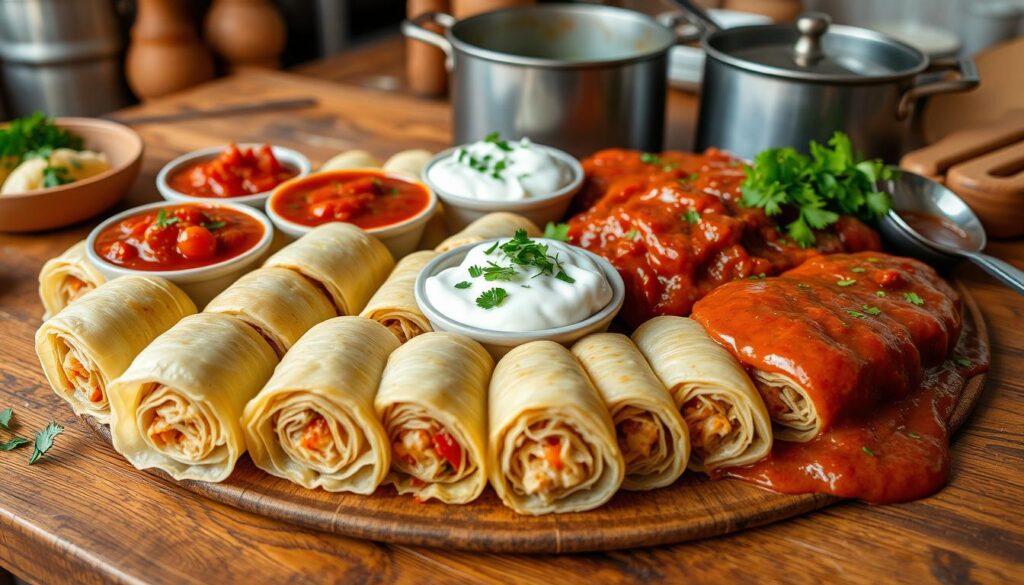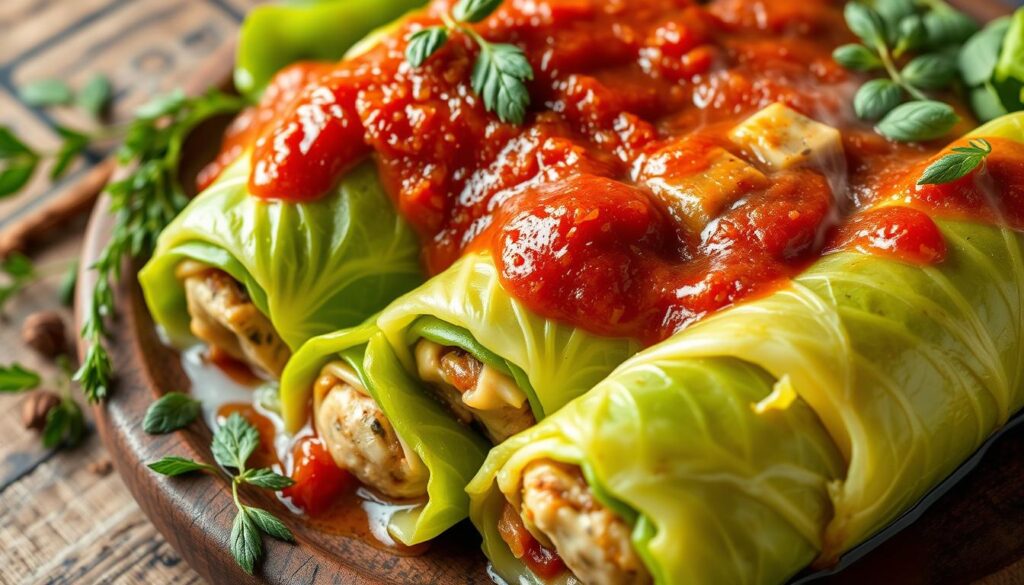I have many happy memories of my grandmother’s kitchen. The smell of her stuffed cabbage rolls was always there. These rolls, filled with meat and wrapped in cabbage, were a big part of our family’s tradition. They were not just food, but a way to connect and feel comforted.
As I’ve gotten older, I’ve learned more about the history and cultural importance of these rolls. They come from Eastern Europe, where they are a cherished dish. In this guide, we’ll look at how to make these rolls at home. You’ll learn how to make delicious cabbage rolls, whether you’re a pro in the kitchen or just starting out.
Key Takeaways
- Discover the rich history and cultural significance of stuffed cabbage rolls, a beloved Eastern European dish.
- Learn the essential ingredients and preparation techniques for creating perfectly wrapped and simmered cabbage rolls.
- Explore regional variations and authentic cooking methods to elevate your cabbage roll experience.
- Understand the proper storage and freezing methods to enjoy this comforting dish for weeks to come.
- Discover delicious serving suggestions and side dish pairings to complement your homemade stuffed cabbage rolls.
The History and Cultural Significance of Stuffed Cabbage Rolls
The stuffed cabbage roll, known as “golabki” in Polish, has a rich history. It comes from Eastern European cuisine. This dish has traveled far, changing with different cultures, and is now loved worldwide.
Origins in Eastern European Cuisine
Stuffed cabbage rolls started in Eastern Europe. They were a favorite for many generations. The exact start is unclear, but it’s thought to be a way to use lots of cabbage and make food stretch.
Traditional Family Recipes Through Generations
For centuries, families have shared their polish cabbage rolls recipes. Each generation made their own changes. These recipes are a big part of family and community ties.
Regional Variations Around the World
As golabki and stuffed cabbage bundles spread, they changed with local tastes. Fillings and sauces vary greatly. This makes the dish even more interesting and diverse.
The polish cabbage rolls are more than just food. They bring families and cultures together. Their journey shows how food can unite and keep traditions alive.
Essential Ingredients for Perfect Cabbage Rolls
Making tasty stuffed cabbage rolls needs the right ingredients. This includes the cabbage leaves, the filling, and the sauce. Each part is crucial for a great dish.
The cabbage leaves are the main ingredient. Choose fresh, firm cabbage with no damage. Blanching the leaves makes them soft and easy to use.
- Ground meat, like pork or beef, or a mix, is the filling’s heart.
- Rice, white or brown, keeps the filling together and adds texture.
- Onions, garlic, and spices like paprika, oregano, and salt and pepper add flavor.
The sauce is key. Tomato-based sauces like marinara or crushed tomatoes are popular. You can also try sour cream or broth for a different taste. The sauce moistens the rolls and adds flavor.
| Ingredient | Purpose |
|---|---|
| Cabbage leaves | The star of the dish, providing the wrapper for the filling |
| Ground pork or beef | The savory, protein-rich filling |
| Rice | Binds the filling and adds texture |
| Onions, garlic, and seasonings | Enhance the flavor of the filling |
| Tomato-based sauce | Provides moisture and additional flavor |
With these ingredients, you’re ready to make delicious pork cabbage rolls or beef cabbage rolls. They’ll make your taste buds happy and take you to a cozy place.
Tips for Selecting and Preparing Fresh Cabbage Leaves
Choosing the right cabbage leaves is crucial for delicious stuffed cabbage rolls. Whether you’re using cooked cabbage leaves or making stuffed cabbage bundles, these tips will help. Your dish will be perfect every time.
Core Removal and Blanching Techniques
Start with a fresh, firm cabbage head. Remove the core carefully to avoid tearing the leaves. Then, boil the cabbage for 2-3 minutes to soften the leaves.
This blanching step keeps the leaves vibrant and tender. It’s key for a great taste and texture.
How to Keep Leaves Intact
- Gently peel off the leaves one by one, taking care not to rip or break them.
- If a leaf tears, you can still use it by overlapping it with another leaf during the wrapping process.
- Maintain the leaves’ moisture by keeping them covered with a damp paper towel or cloth until ready to use.
Proper Storage Methods
Store fresh, uncooked cabbage leaves in the fridge. Wrap them in a damp paper towel or cloth. This keeps them flexible and moist.
Precooked cabbage leaves can be stored in an airtight container or resealable bag in the fridge for up to 3-4 days.
By following these tips, you’ll make mouthwatering cooked cabbage leaves and stuffed cabbage bundles. Your family and friends will love them.
Creating the Perfect Meat Filling for Stuffed Cabbage Rolls
The meat filling is the heart of stuffed cabbage rolls. Whether you choose pork or beef, making the filling just right is crucial. It’s what makes the dish delicious.
Start by picking the right mix of ground meats. Ground beef and pork is a classic choice. But you can also try turkey or even lentils or mushrooms for a meat-free option. Use fresh, high-quality ingredients for the best taste.
- In a large bowl, mix together ground meats, chopped onions, garlic, and seasonings. Salt, pepper, paprika, oregano, and a bit of brown sugar or honey are good choices.
- Mix the ingredients gently until they’re well combined. Avoid overmixing to keep the filling moist and tender.
- Make sure the filling is moist but holds its shape. If it’s too dry, add some broth or tomato sauce.
| Ingredient | Pork Cabbage Rolls | Beef Cabbage Rolls |
|---|---|---|
| Ground Meat | 1 lb ground pork | 1 lb ground beef |
| Onion | 1 medium onion, finely chopped | 1 medium onion, finely chopped |
| Garlic | 3 cloves, minced | 3 cloves, minced |
| Seasoning | Salt, pepper, paprika, oregano, brown sugar | Salt, pepper, paprika, oregano, honey |
With the right meat filling, your stuffed cabbage rolls will be a hit. Your family and friends will love them.
Step-by-Step Guide to Rolling and Wrapping Techniques
Learning to roll and wrap stuffed cabbage rolls is crucial. It ensures your bundles are perfectly shaped and sealed. Follow these steps to make flawless stuffed cabbage rolls every time.
Proper Folding Methods
Start by placing a blanched cabbage leaf shiny-side down on your work surface. Put a generous amount of meat filling in the center of the leaf. Fold the sides over the filling, then roll up the leaf tightly from bottom to top. Secure the roll with a toothpick.
Securing the Rolls
- Use toothpicks or wooden skewers to hold the rolls in place during cooking.
- Arrange the stuffed cabbage rolls tightly together in a baking dish or pot to prevent unraveling.
- Brush the tops of the rolls with a bit of melted butter or olive oil to help them brown evenly.
Common Rolling Mistakes to Avoid
- Overstuffing the cabbage leaves, which can cause them to tear or burst open.
- Not folding the sides of the leaf tightly enough, leading to loose and messy rolls.
- Not securing the rolls properly, resulting in unraveled cabbage bundles during cooking.
By following these techniques, you’ll make beautifully rolled and wrapped stuffed cabbage rolls. They’re sure to impress your family and friends.
Sauce Variations and Cooking Methods
Choosing the right sauce is crucial for cabbage roll recipes. You can pick from classic tomato sauces to creamy options. The choices are endless.
A simple tomato sauce is a favorite. It’s made with diced tomatoes, onions, garlic, and herbs. This sauce goes well with the filling and can be cooked on the stovetop or in the oven.
For a creamier taste, try a sauce with sour cream or yogurt. These add a tangy and creamy flavor. They pair well with the tender cabbage and filling.
There are many ways to cook cabbage rolls. You can use the stovetop for easy simmering. Oven-baking makes them crispy and brown. Or, use a slow cooker for a hands-off cooking experience.
Experimenting with sauces and cooking methods is key. Find what you like best. With a bit of creativity, you’ll make a dish everyone will love.
How to Make Traditional Polish Golabki
If you’re looking for a real taste of Eastern European food, try Polish golabki. These cabbage rolls are filled with ground meat and rice. They’re a favorite in Polish families for generations.
Authentic Polish Seasonings
To get the real taste of Polish golabki, use the right spices and herbs. The key flavors come from:
- Marjoram
- Dill
- Caraway seeds
- Garlic
- Salt and pepper
Traditional Cooking Methods
Making traditional Polish golabki takes time, but it’s worth it. Here’s how to do it:
- Blanch the cabbage leaves in boiling water until soft. Then, drain and remove them carefully.
- In a bowl, mix ground pork or beef, cooked rice, spices, and a bit of broth or tomato sauce.
- Put some filling on each cabbage leaf, then roll and secure it.
- Put the rolls in a baking dish and top with a tomato or mushroom sauce.
- Bake until the filling is cooked and the sauce thickens.
By using these methods and Polish flavors, you can enjoy a taste of Eastern Europe. It’s a true culinary experience.
| Ingredient | Quantity |
|---|---|
| Cabbage leaves | 12-16 large |
| Ground pork or beef | 1 lb |
| Cooked rice | 1 cup |
| Marjoram | 1 tsp |
| Dill | 1 tsp |
| Caraway seeds | 1/2 tsp |
| Garlic, minced | 2 cloves |
| Salt and pepper | to taste |
| Tomato sauce or broth | 2 cups |
By following these steps and using Polish flavors, you can enjoy a taste of Eastern Europe. It’s a true culinary experience.
Storing and Freezing Your Cabbage Rolls
Keeping your homemade stuffed cabbage rolls fresh is important. This way, you can enjoy their taste and texture for a longer time. Whether you have leftovers or want to make them ahead, these tips will help.
Refrigerating Cooked Cabbage Rolls
Let cooked stuffed cabbage rolls cool down before storing them. Put them in an airtight container. They stay good for up to 4 days in the fridge.
When you reheat, use the oven, microwave, or skillet. This keeps the rolls moist and tasty.
Freezing Cabbage Rolls for Later
You can freeze cabbage roll casserole or individual rolls for longer. Cool the rolls first. Then, put them on a baking sheet and freeze until solid.
Move them to a freezer-safe bag or container. They can stay frozen for up to 3 months. To reheat, bake at 350°F for 30-40 minutes.
| Storage Method | Shelf Life | Reheating Tips |
|---|---|---|
| Refrigerator | Up to 4 days | Oven, microwave, or skillet |
| Freezer | Up to 3 months | Bake at 350°F until heated through |
These tips help you enjoy your stuffed cabbage rolls even after they’re made. Whether you’re planning meals or have leftovers, storing them right is crucial. It keeps the dish fresh and flavorful.
Serving Suggestions and Side Dish Pairings
When serving your stuffed cabbage rolls, how you present them matters. Place the rolls on a platter and drizzle the sauce over them. This makes for a beautiful sight. Add some fresh parsley or dill on top for color and taste.
There are many sides you can choose. Mashed potatoes or white rice are great for soaking up the sauce. A green salad or steamed veggies like carrots or green beans add nutrition to your meal.
Wine lovers might enjoy a medium-bodied red like Merlot or Cabernet Sauvignon. It pairs well with the rolls. For a lighter choice, try a dry white wine like Pinot Grigio or Chardonnay. If you don’t drink alcohol, cucumber water or iced tea can be a nice alternative.
FAQ
What is the history and cultural significance of stuffed cabbage rolls?
Stuffed cabbage rolls, known as golabki in Polish, have a rich history. They come from Eastern Europe and are a beloved comfort food. Over time, recipes have spread worldwide, showing the diversity of global cuisines.
What are the essential ingredients for making perfect cabbage rolls?
To make great stuffed cabbage rolls, you need fresh cabbage, ground meat, rice, onions, garlic, and seasonings. These ingredients give the dish its unique taste and texture.
How do I properly prepare and handle the cabbage leaves for stuffed cabbage rolls?
Preparing the cabbage leaves is key. Remove the core and blanch the leaves to make them pliable. Handle them gently to avoid tearing. Store them properly until you’re ready to assemble the rolls.
What is the best way to create the perfect meat filling for stuffed cabbage rolls?
The meat filling is crucial. Mix ground meat, cooked rice, sautéed onions, garlic, and seasonings carefully. This ensures a flavorful, moist filling that holds its shape.
How do I properly roll and wrap the cabbage leaves around the filling?
Rolling the cabbage leaves is essential. Place the filling at the leaf’s base, fold the sides, and roll it up. Use toothpicks or string to keep the rolls tight during cooking.
What are the different sauce variations and cooking methods for stuffed cabbage rolls?
You can serve cabbage rolls with many sauces, like tomato-based or creamy. Cooking methods include stovetop, oven, or slow cooker. Choose what suits you best.
How can I make traditional Polish golabki?
For authentic Polish golabki, use traditional seasonings like marjoram and caraway seeds. Slow simmering or baking is best to get the dish’s unique flavor and texture.
How can I store and freeze my cabbage rolls for later enjoyment?
To enjoy cabbage rolls later, store them properly. Cooked rolls can be refrigerated for 4 days or frozen for months. Reheat gently to preserve texture and flavor.
What are some serving suggestions and side dish pairings for stuffed cabbage rolls?
Serve cabbage rolls with mashed potatoes, egg noodles, or a green salad. For a bigger meal, add sautéed mushrooms or roasted vegetables. A glass of wine complements the flavors well.



